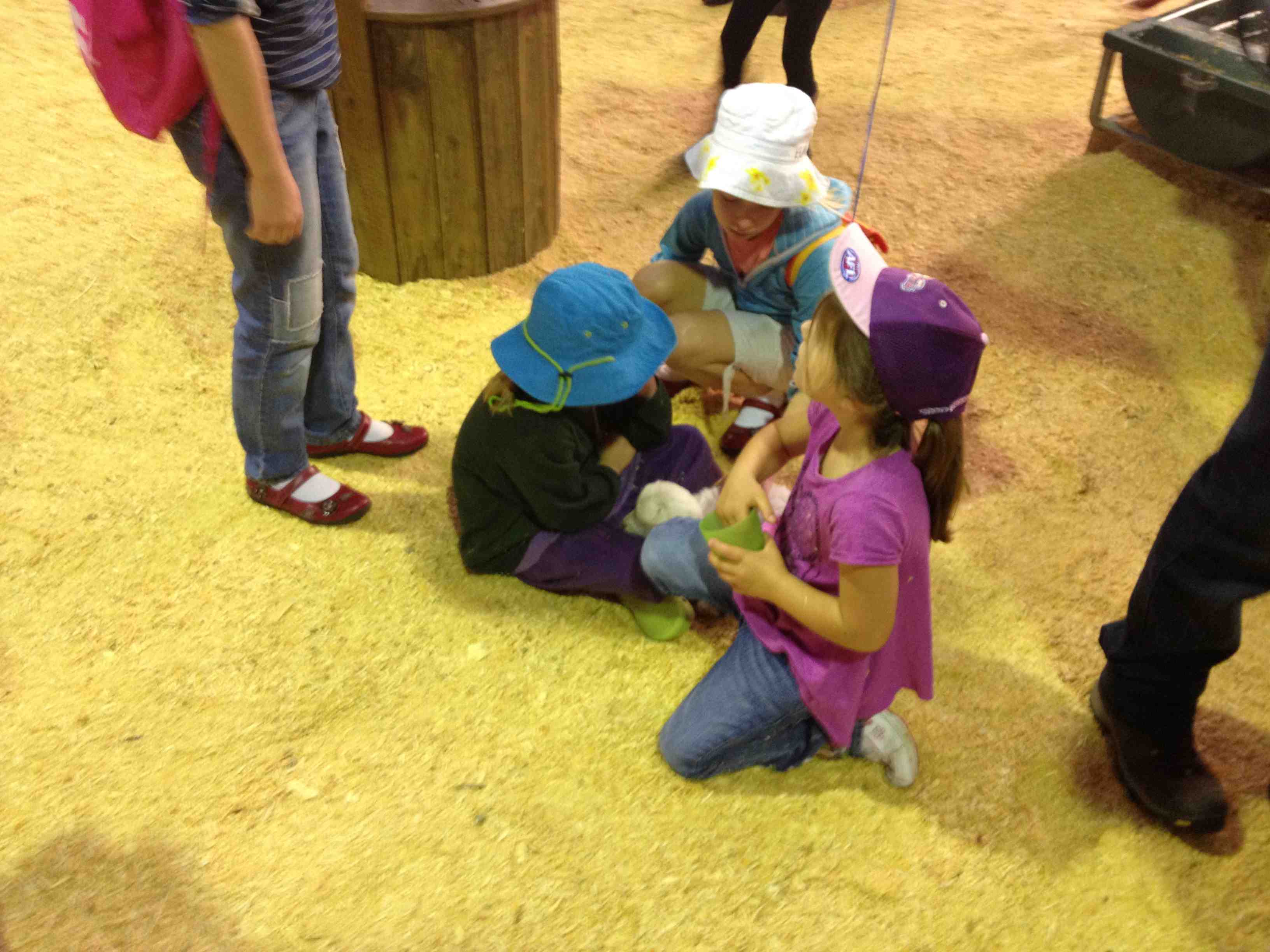Yesterday we joined over 70,000 for our second People’s Day at the Ekka.
The petting zoo was a mess.
The Brisbane Exhibition, or Ekka, runs over 10 days and is similar to American-style state fairs or the CNE in Toronto: bad food, hucksters of various wares, a large midway, and the  best livestock from across the state.
best livestock from across the state.
There was a petting zoo, a sorta controlled-chaos the like of which I’d never seen (left, exactly as shown) where hundreds of parents and their kids roamed in a large enclosure with goats, sheep, cattle, and shelled out some cash to feed the animals from a cup. Kids were crying and falling in poop, animals were scarfing down food, parents were chatting with friends and not noticing their toddler doing things that shouldn’t be done in a petting zoo.
At one point, Amy told Sorenne not to put her fingers in her mouth after petting an animal; the mother next to her told her kid, “Yeah, don’t put your fingers in your mouth.”
Amy couldn’t tell if it was sarcasm or sincere.
Both hand sanitation and handwashing stations were available at the departure point, which was good, although reminders could have been more effective: the compliance rate appeared low. As Anderson and Weese found in 2011 at a temporary petting zoo in Guelph using video observation, 58 per cent of visitors performed some form of hand hygiene (either using water, soap and water, or hand sanitizer), and two interventions (improved signage while offering hand sanitizer, and verbal hand hygiene reminders by venue staff)  were associated with increased hand hygiene compliance. U.K. health officials currently recommend handwashing stations with soap and water only (no wipes or sanitizers).
were associated with increased hand hygiene compliance. U.K. health officials currently recommend handwashing stations with soap and water only (no wipes or sanitizers).
There was a person collecting feed cups at the exit (which we did not buy) but she said nothing about handwashing as I left.
And handwashing is never enough. While some studies suggest inadequate handwashing facilities may have contributed to enteric disease outbreaks or washing hands was protective against illness, others suggest relevant infectious agents may be aerosolized and inhaled. Handwashing tool selection may also contribute to the success of hand hygiene as a preventive measure, as some outbreak investigations have reported alcohol-based hand sanitizer was not protective against illness, especially when hands are soiled.
All the refs can be found in our recent paper, a sorta secret petting zoo shopper, Observation of public health risk behaviors, risk communication and hand hygiene at Kansas and Missouri petting zoos – 2010-2011.
Snappy title.
I’m fine with animal interactions; but people, and organizers, should be a lot more careful than they thought. That’s what I told my 3-year-old’s daycare as they prepared for a  chicken coop. I’m not sure people like that message.
chicken coop. I’m not sure people like that message.
A table of petting zoo outbreaks is available at http://bites.ksu.edu/petting-zoos-outbreaks.
Erdozain G, Kukanich K, Chapman B, Powell D. 2012. Observation of public health risk behaviours, risk communication and hand hygiene at Kansas and Missouri petting zoos – 2010-2011. Zoonoses Public Health. 2012 Jul 30. doi: 10.1111/j.1863-2378.2012.01531.x. [Epub ahead of print]
Observation of public health risk behaviors, risk communication and hand hygiene at Kansas and Missouri petting zoos – 2010-2011Outbreaks of human illness have been linked to visiting settings with animal contact throughout developed countries. This paper details an observational study of hand hygiene tool availability and recommendations; frequency of risky behavior; and, handwashing attempts by visitors in Kansas (9) and Missouri (4), U.S., petting zoos. Handwashing signs and hand hygiene stations were available at the exit of animal-contact areas in 10/13 and 8/13 petting zoos respectively. Risky behaviors were observed being performed at all petting zoos by at least one visitor. Frequently observed behaviors were: children (10/13 petting zoos) and adults (9/13 petting zoos) touching hands to face within animal-contact areas; animals licking children’s and adults’ hands (7/13 and 4/13 petting zoos, respectively); and children and adults drinking within animal-contact areas (5/13 petting zoos each). Of 574 visitors observed for hand hygiene when exiting animal-contact areas, 37% (n=214) of individuals attempted some type of hand hygiene, with male adults, female adults, and children attempting at similar rates (32%, 40%, and 37% respectively). Visitors were 4.8x more likely to wash their hands when a staff member was present within or at the exit to the animal-contact area (136/231, 59%) than when no staff member was present (78/343, 23%; p<0.001, OR=4.863, 95% C.I.=3.380-6.998). Visitors at zoos with a fence as a partial barrier to human-animal contact were 2.3x more likely to wash their hands (188/460, 40.9%) than visitors allowed to enter the animals’ yard for contact (26/114, 22.8%; p<0.001, OR= 2.339, 95% CI= 1.454-3.763). Inconsistencies existed in tool availability, signage, and supervision of animal-contact. Risk communication was poor, with few petting zoos outlining risks associated with animal-contact, or providing recommendations for precautions to be taken to reduce these risks.

